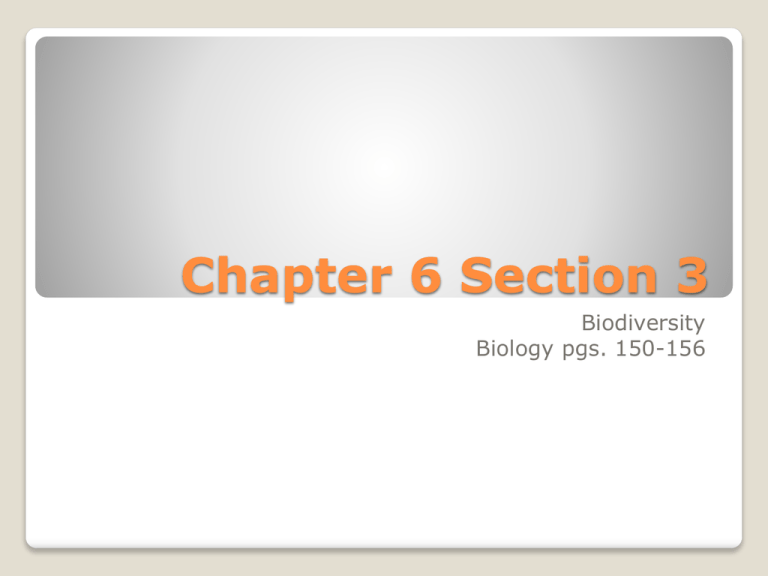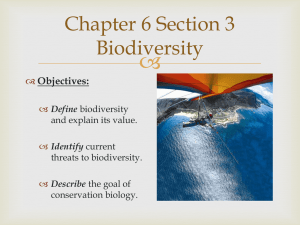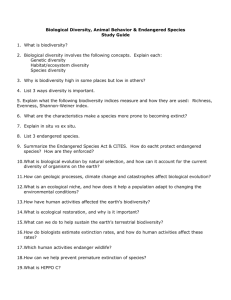
Chapter 6 Section 3
Biodiversity
Biology pgs. 150-156
Define
___________
biodiversity and explain its
value
Identify
______________current
threats to
biodiversity
_____________the
goal of conservation
Describe
biology
Objectives
The Value of Biodiversity
Biological diversity,
or________________________,
is the sum total
biodiversity
of the genetically based variety of all organisms in
the biosphere.
_________________________includes
the
Ecosystem diversity
variety of habitats, communities, and ecological
processes in the living world.
Species diversity
_____________________is
the number
of different species in the biosphere.
_________________is
the sum total of all
Genetic diversity
the different forms of genetic information
carried by all organisms living on Earth
today.
◦ Biodiversity is one of Earth's
greatest
__________________natural
resources.
◦ Species of many kinds have provided us with
foods, industrial products, and medicines—
including painkillers, antibiotics, heart drugs,
antidepressants, and anticancer drugs.
Threats to Biodiversity
◦ Human activity can _____________biodiversity
reduce
by:
altering habitats
hunting species to extinction
introducing toxic compounds into food webs
introducing foreign species to new
environments
Extinction
_______________________occurs
when a
species disappears from all or part of its
range.
A species whose population size is declining
in a way that places it in danger of extinction
endangered species
is called an_________________________.
As the population of an endangered species
declines, the species loses genetic diversity.
Habitat Alteration
When land is developed, natural habitats may be
destroyed.
Development often splits ecosystems into pieces, a
process called___________________________.
habitat fragmentation
The smaller a species’ habitat is, the more vulnerable
the species is to further disturbance.
Demand for Wildlife Products
Throughout history, humans have pushed some
extinction
animal species to _______________________by
hunting them for food or other products.
Today, in the U.S., endangered species are
protected from hunting.
The Convention on International Trade in
Endangered Species, CITES, bans
international trade in products derived
from endangered species.
Pollution
pollution
Many forms of ______________________can
threaten biodiversity.
One of the most serious problems occurs when
toxic compounds accumulate in the tissues of
organisms.
DDT
________________,
one of the first pesticides, is
a good example of this.
For a long time DDT was considered harmless,
and it drained into rivers and streams in low
concentrations.
However, DDT has two hazardous properties:
◦ It is__________________________,
which means that
nonbiodegradable
it cannot be broken down by organisms.
◦ Once DDT is picked up by organisms, it cannot be
eliminated from their bodies.
When DDT enters food webs, it undergoes
biological magnification.
In_____________________________,
biological magnification
concentrations of a harmful substance
increase in organisms at higher trophic
levels in a food chain or food web.
In 1962, biologist Rachel Carson wrote
Silent Spring, which alerted people to the
dangers of biological magnification.
Magnification of
DDT
Concentration
Pollution
Copyright Pearson Prentice Hall
Magnification of
DDT
Concentration
Pollution
Copyright Pearson Prentice Hall
Magnification of
DDT
Concentration
Pollution
Copyright Pearson Prentice Hall
Magnification of
DDT
Concentration
Pollution
Copyright Pearson Prentice Hall
Magnification of
DDT
Concentration
Pollution
Copyright Pearson Prentice Hall
Magnification of
DDT
Concentration
Pollution
Copyright Pearson Prentice Hall
The widespread use of DDT threatened
populations of many animals—especially fisheating birds like the bald eagle—with
extinction.
By the early 1970s, DDT was banned in the
U.S. and in most other industrialized
countries; as a result, affected bird
populations have recovered.
Introduced Species
Another threat to biodiversity comes from plants and
animals that humans transport around the world either
accidentally or intentionally.
Invasive species
____________________________are
introduced
species that reproduce rapidly because their new
habitat lacks the predators that would control their
population.
Hundreds of invasive species—including
zebra mussels
____________________in
the Great Lakes
and the leafy spurge across the Northern
Great Plains—are already causing ecological
problems in the United States.
Conserving Biodiversity
Conservation
________________________is
the wise
management of natural resources, including
the preservation of habitats and wildlife.
Strategies for Conservation
Many conservation efforts are aimed at
managing individual species to keep them
from becoming extinct.
◦ Conservation efforts focus on
________________________entire
protecting
ecosystems as well as single species.
◦ Protecting an ecosystem will ensure that the
natural habitats and the interactions of many
different species are preserved at the same
time.
◦ Conservation Challenges
Protecting resources for the future can require
people to change the way they earn their living
today.
regulations
Conservation ___________________must
be
informed by solid research and must try to
maximize benefits while minimizing economic
costs.









